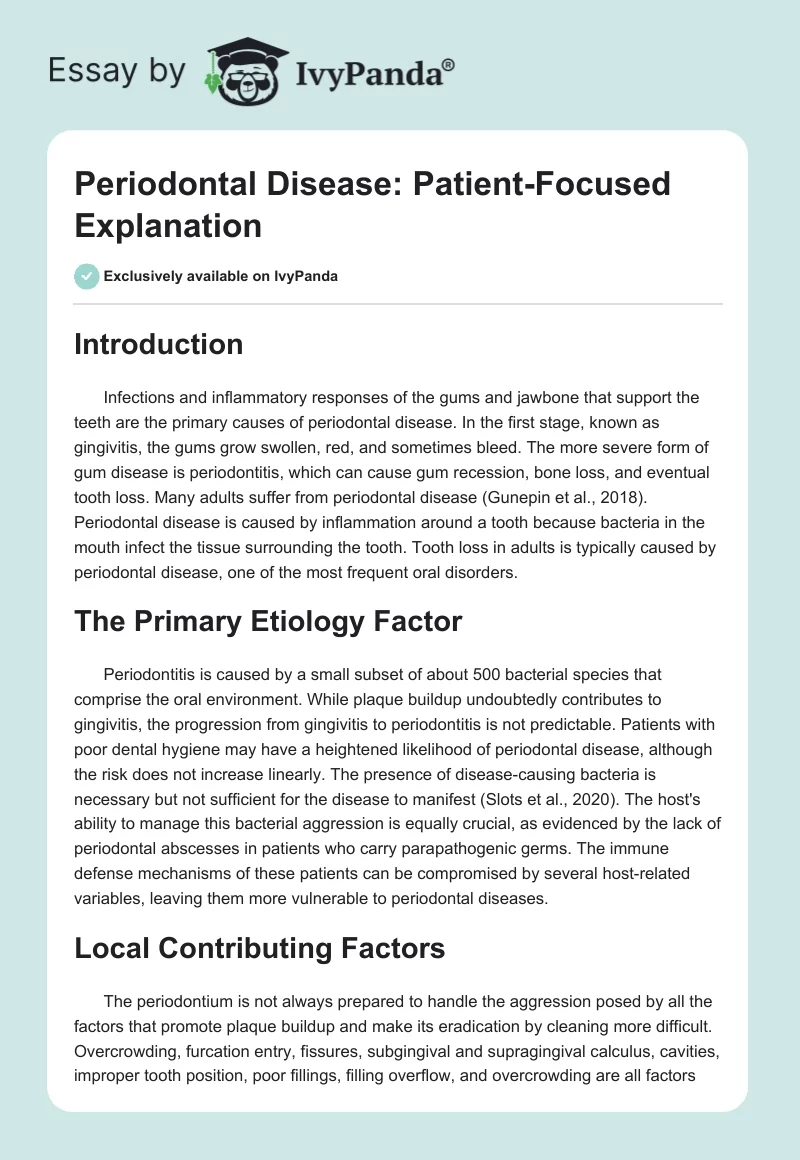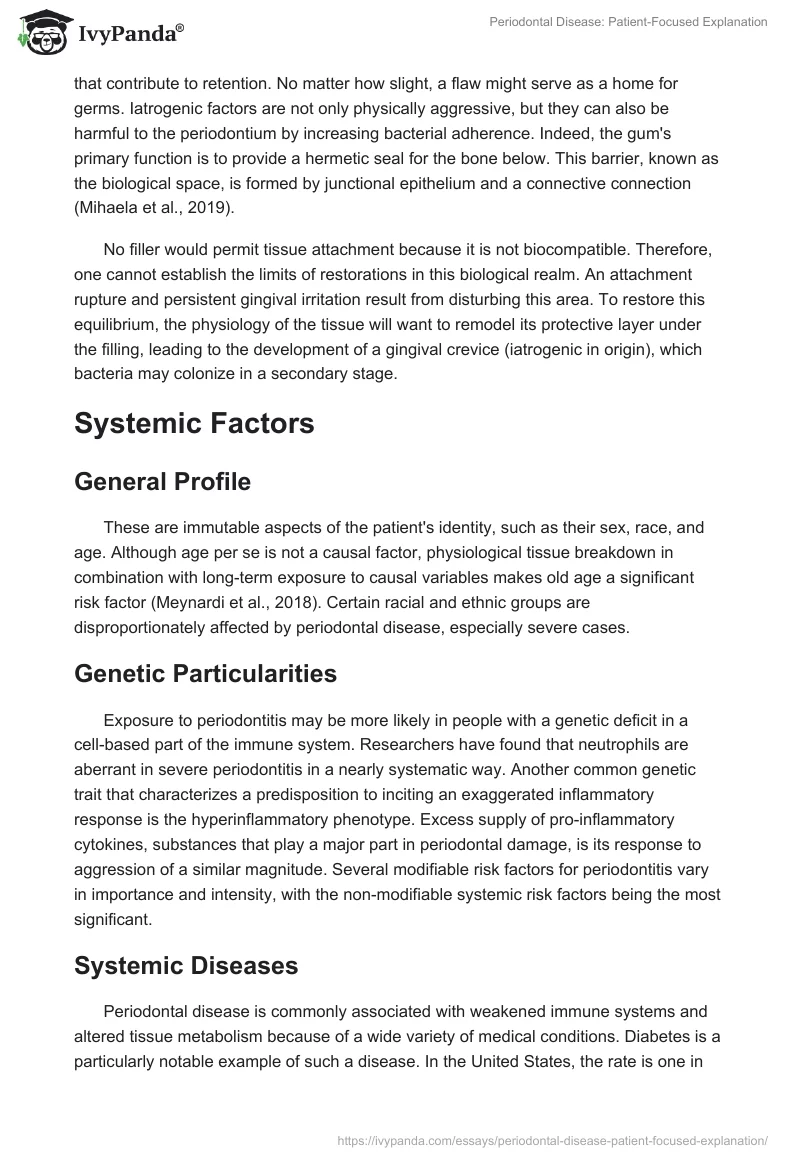Introduction
Infections and inflammatory responses of the gums and jawbone that support the teeth are the primary causes of periodontal disease. In the first stage, known as gingivitis, the gums grow swollen, red, and sometimes bleed. The more severe form of gum disease is periodontitis, which can cause gum recession, bone loss, and eventual tooth loss. Many adults suffer from periodontal disease (Gunepin et al., 2018). Periodontal disease is caused by inflammation around a tooth because bacteria in the mouth infect the tissue surrounding the tooth. Tooth loss in adults is typically caused by periodontal disease, one of the most frequent oral disorders.
The Primary Etiology Factor
Periodontitis is caused by a small subset of about 500 bacterial species that comprise the oral environment. While plaque buildup undoubtedly contributes to gingivitis, the progression from gingivitis to periodontitis is not predictable. Patients with poor dental hygiene may have a heightened likelihood of periodontal disease, although the risk does not increase linearly. The presence of disease-causing bacteria is necessary but not sufficient for the disease to manifest (Slots et al., 2020). The host’s ability to manage this bacterial aggression is equally crucial, as evidenced by the lack of periodontal abscesses in patients who carry parapathogenic germs. The immune defense mechanisms of these patients can be compromised by several host-related variables, leaving them more vulnerable to periodontal diseases.
Local Contributing Factors
The periodontium is not always prepared to handle the aggression posed by all the factors that promote plaque buildup and make its eradication by cleaning more difficult. Overcrowding, furcation entry, fissures, subgingival and supragingival calculus, cavities, improper tooth position, poor fillings, filling overflow, and overcrowding are all factors that contribute to retention. No matter how slight, a flaw might serve as a home for germs. Iatrogenic factors are not only physically aggressive, but they can also be harmful to the periodontium by increasing bacterial adherence. Indeed, the gum’s primary function is to provide a hermetic seal for the bone below. This barrier, known as the biological space, is formed by junctional epithelium and a connective connection (Mihaela et al., 2019).
No filler would permit tissue attachment because it is not biocompatible. Therefore, one cannot establish the limits of restorations in this biological realm. An attachment rupture and persistent gingival irritation result from disturbing this area. To restore this equilibrium, the physiology of the tissue will want to remodel its protective layer under the filling, leading to the development of a gingival crevice (iatrogenic in origin), which bacteria may colonize in a secondary stage.
Systemic Factors
General Profile
These are immutable aspects of the patient’s identity, such as their sex, race, and age. Although age per se is not a causal factor, physiological tissue breakdown in combination with long-term exposure to causal variables makes old age a significant risk factor (Meynardi et al., 2018). Certain racial and ethnic groups are disproportionately affected by periodontal disease, especially severe cases.
Genetic Particularities
Exposure to periodontitis may be more likely in people with a genetic deficit in a cell-based part of the immune system. Researchers have found that neutrophils are aberrant in severe periodontitis in a nearly systematic way. Another common genetic trait that characterizes a predisposition to inciting an exaggerated inflammatory response is the hyperinflammatory phenotype. Excess supply of pro-inflammatory cytokines, substances that play a major part in periodontal damage, is its response to aggression of a similar magnitude. Several modifiable risk factors for periodontitis vary in importance and intensity, with the non-modifiable systemic risk factors being the most significant.
Systemic Diseases
Periodontal disease is commonly associated with weakened immune systems and altered tissue metabolism because of a wide variety of medical conditions. Diabetes is a particularly notable example of such a disease. In the United States, the rate is one in twenty, but experts anticipate that without intervention, that number will augment rapidly over the next several years. The fact that one-third of the population does not even know about it makes these numbers that shocking (Meynardi et al., 2018). Periodontal disease is highly common in those with diabetes. Diabetic periodontal disease is more challenging to treat in a patient with poor glucose control. Given that the relationship between periodontitis and diabetes is regarded as two-way, playing a unique role is crucial. True, periodontitis would worsen diabetes by affecting glycemic control.
Tobacco
Cigarette smoking is widely acknowledged as a significant contributor to periodontal disease. Tobacco’s negative effects can be traced back to the nicotine and other chemicals it contains. The body’s ability to fight off microorganisms has been compromised. Due to a decrease in vascularization, the signs of gum inflammation are typically disguised. Periodontal therapies have a negative effect on smokers, especially heavy smokers. Because the doctor can’t do anything about a patient’s smoking habit, it must be factored into the patient’s analysis, treatment, and prognosis. The patient needs to be made aware of the risks and rewards associated with quitting smoking.
Medications
Cyclosporine (an immunosuppressant), phenytoin (an antiepileptic), and nifedipine (a calcium channel blocker) are the most commonly prescribed drugs that contribute to periodontal problems (calcium channel blockers). Hyperplasia or enlargement of the gums is a common cause of these lesions (Meynardi et al., 2018). These clinical symptoms, which are present in the edentulous, arise from the medications’ effects on metabolic activities and (fat) inflammatory processes connected to the existence of plaque.
Stress
Chronic rather than acute stress is to blame for periodontal disease. Periodontal disease is related less to stress than to the incapacity to deal with distress. Both systemically, where it affects immunological functions, and locally, where it contributes to the patient’s gingiva condition, stress affects the periodontium. Anxious patients often acquire parafunctions (such as clenching teeth or bruxism) to mitigate their anxiety’s negative effects. In addition to the neuro-immune-endocrine interaction relating to the effects of the secretion of chemicals like cortisol, this can occur because of changes in behavior like smoking and poor dental hygiene. The hypothalamus and the autonomic nervous system become more active in reaction to stress, leading to these responses (Meynardi et al., 2018). Identifying subjects with chronic stress and implementing countermeasures to reduce the effects of distress on the periodontium necessitates interdisciplinary patient care by clinicians, oral surgeons, and psychologists.
Conclusion
Periodontal disease is caused by infections and inflammation of the jawbone and gums that surround and support the teeth. The initial phase is called gingivitis, characterized by red, swollen, and sometimes bleeding gums. Periodontitis, the more severe form of gum disease, can lead to gum recession, bone loss, and the loss of teeth. Periodontal disease is a leading cause of tooth loss in adults. It is also one of the most common oral diseases. There are about 500 different kinds of bacteria in the mouth, but only a small percentage of those cause periodontitis. Because of its indirect effects on the periodontium, chronic stress can negatively affect periodontal disease’s onset, progression, and response to therapy.
References
Gunepin, M., Derache, F., Trousselard, M., Salsou, B., & Risso, J. J. (2018). Impact of chronic stress on periodontal health. Journal of Oral Medicine and Oral Surgery, 24(1), 44-50. Web.
Meynardi, F., Lauritano, D., Pasqualini, M. E., Rossi, F., Grivet-Brancot, L., Comola, G., Dal Carlo, L., Moglioni, E., & Zampetti, P. (2018). The importance of occlusal trauma in the primary etiology of periodontal disease. Journal of Biological Regulators and Homeostatic Agents, 32(2 Suppl 1), 27-34.
Mihaela, M., Cristian, I. D., Ramona, D. A., & Condurache, G. (2019). Assessment of local risk factors in the etiology and evolution of periodontal diseases. Romanian Journal of Oral Rehabilitation, 11, 115-121.
Slots, J. (2020). Primer on etiology and treatment of progressive/severe periodontitis: A systemic health perspective. Periodontology 2000, 83(1), 272-276.


